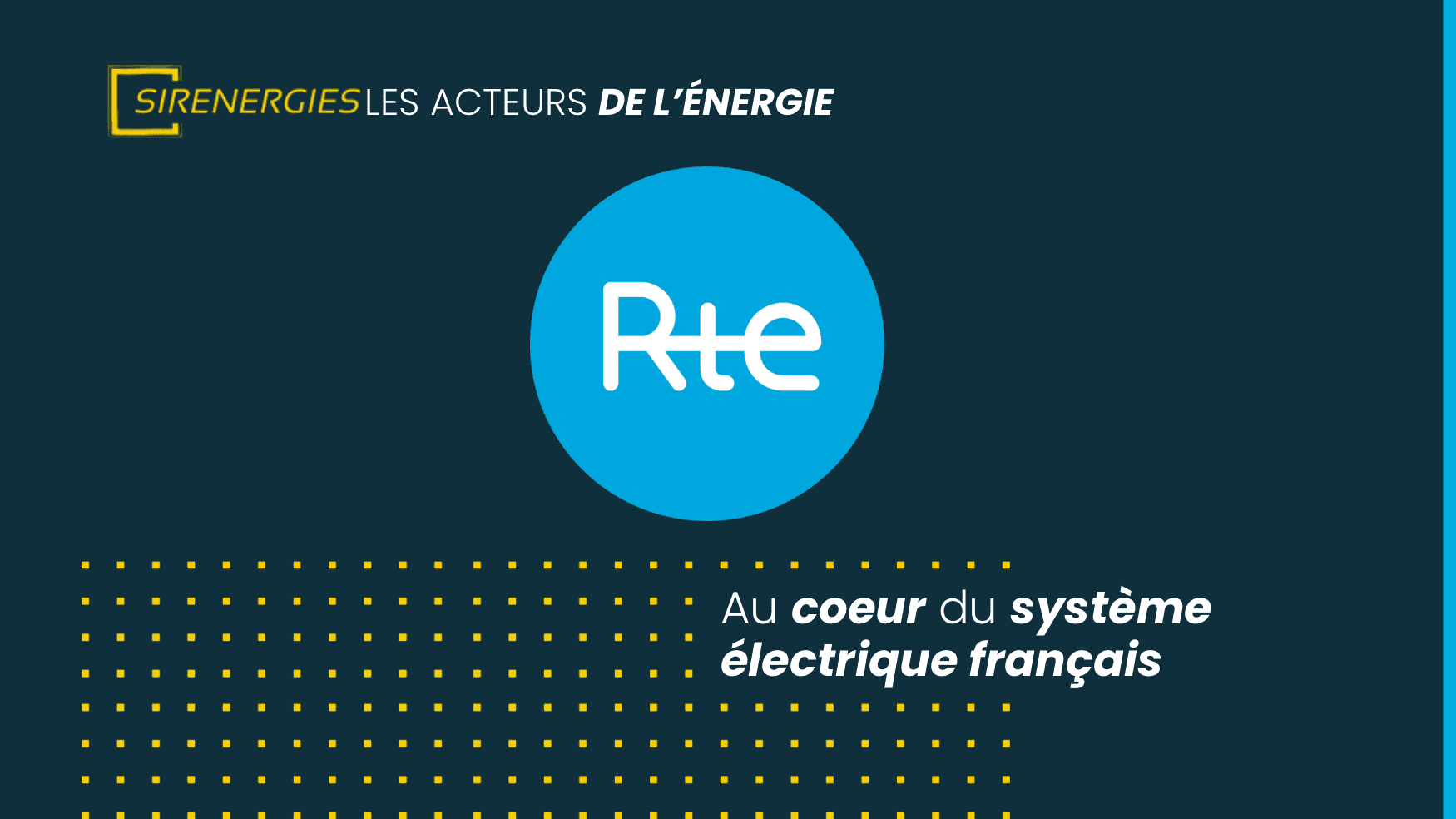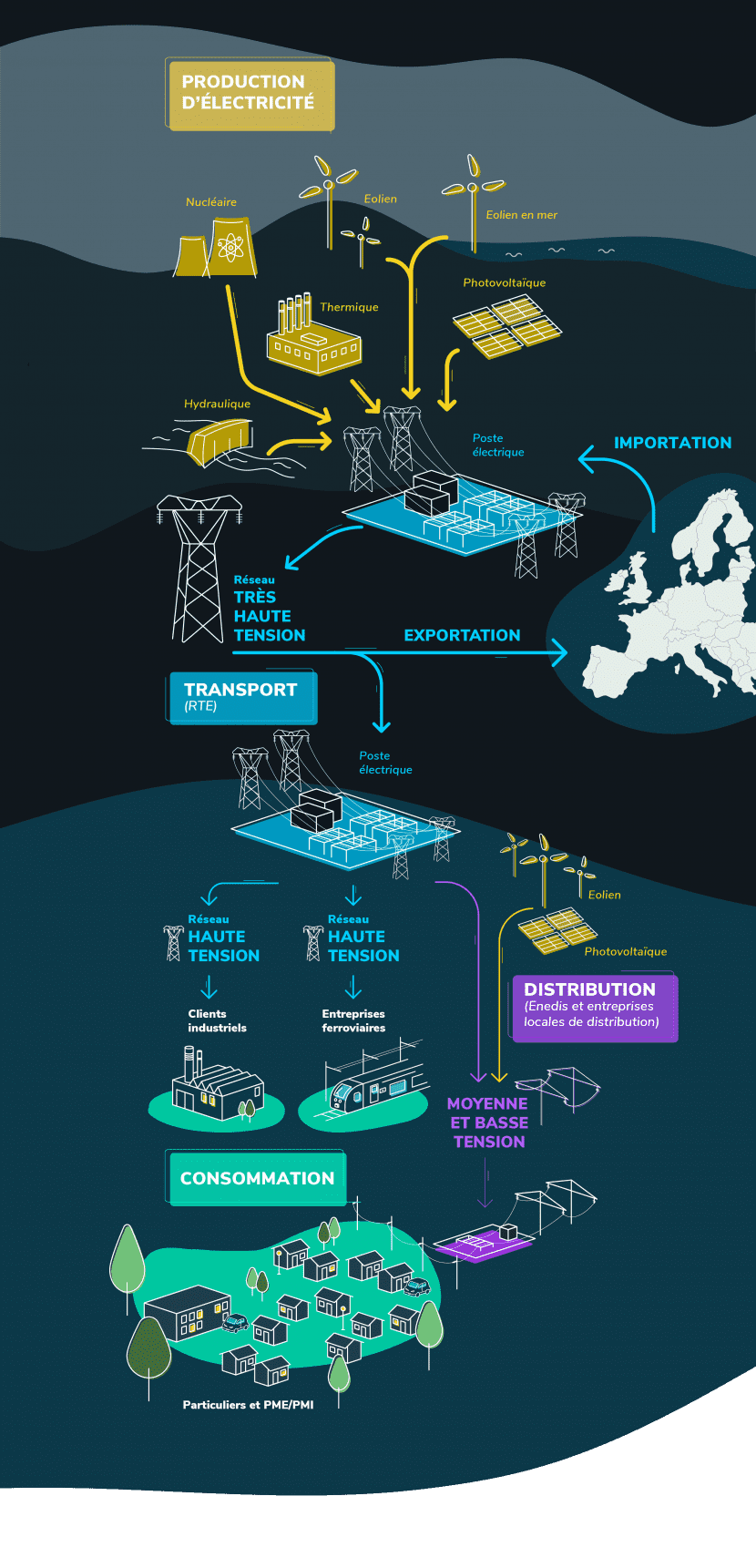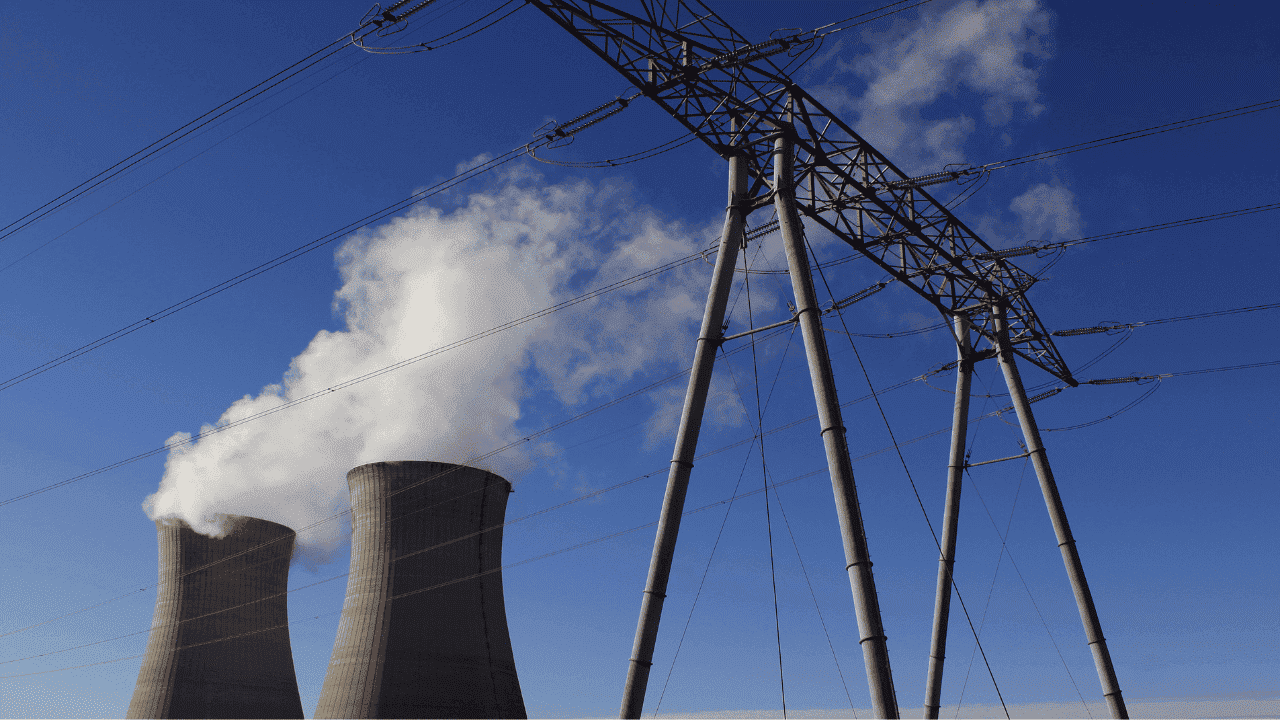
Virginie
LEFÈVRE
Rédactrice Sirenergies
Table of contents
RTE: At the heart of the French electricity system
January 31, 2024
6
Min reading

From the place of production to the place of consumption, electricity travels for many kilometers. It covers long distances via the public high and very high voltage electricity transmission network that crisscrosses France. Then it is distributed locally by the public low and medium voltage distribution network.
Each network has different organizations and rules. Today, let's discover RTE, the operator of the long-distance electricity transmission system.
Who is RTE?
The birth of RTE
Unlike the “old lady” EDF, RTE is a relatively recent company, founded in the early 2000s to support the opening of energy markets to competition.
At the origin of its creation? The need for Separate accounting, on the one hand, monopoly electricity transmission and distribution activities and, on the other hand, production activities that are partially open to competition.
This obligation derives from the European directive of 1996, transposed in France into the law of 10 February 2000 relating to the modernization and development of public electricity services.
In 2000, EDF loses its monopoly and RTE becomes an independent service, with separate management, accounting and management.
It was not until 2005 that the company took off., with the creation of its own legal structure. RTE becomes a public limited company, an independent subsidiary of the EDF Group. Its statutes give it a perfect neutrality with respect to all electricity producers.
Since 2016, 50.1% of RTE's capital has been owned by EDF, 29.9% by Caisse des Dépôts and 20% by CNP Assurances.
The missions and role of RTE in the French electricity system
In his own words, RTE's main mission is ” maintain, operate and develop the electricity transmission network in a strictly equitable and non-discriminatory manner for all actors in the electrical system”. And that's no small thing! With nearly 106,000 km of power lines, the French transport network is one of the most important in Europe.

The place of the transport network in the French and European electricity landscape — Source: RTE
But its role does not end with the physical transport network. Electricity has a limit: it cannot be stored in large volumes. Once produced, it must be consumed.
It is RTE who Ensures the optimization of the network and guarantees maximum power safety. As early as 2003, the company set up a adjustment mechanism.
The transport of electricity, a regulated activity
RTE is a company in a monopoly position, regulated by the Energy Regulatory Commission (CRE).
In concrete terms, RTE's investments are approved by the CRE and 90% of its revenue comes from TURPE HTB, the rate for using the public high and very high voltage electricity network. It is a regulated rate, set by the CRE, and paid by customers connected to the transport network. The current rate dates from 2021 (TURP 6) and applies for a period of four years.
What are RTE's activities?
Management of the French electricity network
Electricity is a public service. The historical mission of RTE is to make electricity available for all, 24 hours a day, 7 days a week.
Maintaining the transport network
Transporting electricity over long distances requires efficient infrastructures.
For RTE, this represents 100,000 km of overhead lines, 5,000 km of underground lines, 280,000 electricity pylons and 2,783 electrical stations to be maintained and maintained for anticipate breakdowns, prevent equipment wear and tear and secure the electrical network.
La preventive maintenance Doubles withemergency interventions. 1,170 maintenance teams and 4,000 employees crisscross the country to repair breakdowns and damage caused to transport infrastructures.
Thanks to this daily commitment, The continuity of the electrical supply is close to 100%.
Increase transport capacity to meet new needs
Faced with new electricity needs, RTE prioritizes optimizing and strengthening existing infrastructures to network extensions. The objective? Preserving landscapes and biodiversity, while reducing The carbon footprint and costs.
Each year, the network operator invests €1,500 million for increase the transport capacity of lines and avoid new constructions.
Balancing electricity supply and demand
RTE insures the balance between supply and demand. With its national operating center, its 7 regional control centers and its 200 dispatchers, the company continuously monitors the transport network. The challenge? Get electricity to the right place, at the right time, in the right quantities.
The adjustment mechanism makes it possible to anticipate imbalances between supply and demand. Through balancing offers with adjustment actors, RTE can activate the temporary increase or decrease in the production of a power plant or in the consumption of a large industrial customer in exchange for financial compensation.
State of the network, level of production and consumption, weather...: to establish its forecasts in real time, RTE brasse 40,000 pieces of information per second. Some of this data is made public on the site and the application Eco₂ Mix.
RTE services for businesses
RTE ensures the distribution of electricity for large consumers. This represents 920 customers including producers, distributors (Enedis, ELD...) and market players who buy and sell electricity.
Nearly half are industrial customers (railway companies, steel, chemical, automotive, etc.).
Connecting customers to the transport network
RTE guarantees its customers access to the transport network. The company analyzes each project to propose flexible connection solutions with optimized costs and deadlines.

Transport network — Source: EDF, July 2020
Manage contracts and data
RTE supports its customers in the control of their budget And theoptimizing their consumption.
Through the Service Portal, customers have access to a wealth of data and resources to manage their production or racking with agility of electricity. They receive alerts if the consumption threshold or the Phi tangent threshold is exceeded, reactive power.
What are RTE's plans for the future?
Energy crisis, climate change, evolution of user behavior, rise of self-consumption and renewable energies...: the electricity sector is at the heart of political, climatic, economic and social upheavals.
RTE must anticipate and adapt. Today, he is responsible for the Impulsion and Vision 2050 business project.
Integrating renewable energies
Carbon neutrality In 2050 is the crosshairs of European governments. In France, the strategy is based on three pillars: sobriety, the revival of civil nuclear power and renewables.
Integrating renewable electricity production into the transmission network is one of RTE's major challenges. The difficulty is twofold: on the one hand, to guarantee a sufficient transport capacity to accommodate the GWh produced; on the other hand, maintain the supply-demand balance by integrating a intermittent production and unequal on the territory.
To adapt, RTE imagines new levers of flexibility through solutions for erasing, storing and adapting the network. Example: the RINGO project (2021), which is experimenting with electricity storage automated on a large scale.
Innovating and adapting RTE's industrial tool
To improve performance, RTE is developing new digital solutions.
Among the projects in progress: “new generation” electrical substations digital, more powerful and compact, capable of integrating up to 30% renewable energy. The company also relies on artificial intelligence to optimize the Dispatching.
RTE is continuously improving network security and is experimenting with more resistant equipment and materials, such as anti-waterfall pylons or carbon fiber-based aerial cables.
Increasing European interconnection
The war in Ukraine illustrates the risks that weigh on the supply of European countries. Strengthening interdependence and solidarity between electrical systems is a priority.
Because of its geographical position, the French network is a crossroads in Europe. RTE is committed to strengthening cooperation between the 43 TSOs and extending market coupling. By 2035, The network manager Aims to double the capacity of cross-border connections. Today, 450 TWh are already exchanged each year via 420 interconnections, including 50 at French borders.
At the heart of the French electricity system, RTE is the guarantor of the electricity supply in France. His ambition? “Offer safe, economical and clean access to electrical energy for all”. This requires efficient transport infrastructures, quality customer service, the management of millions of data, efficient European interconnections and complex market and adjustment mechanisms.
Through its missions, RTE is an essential link in preparing the electricity network of tomorrow and adapting it to energy challenges.
Do not hesitate to consult our article on Ecowatt, the electricity weather according to RTE.










